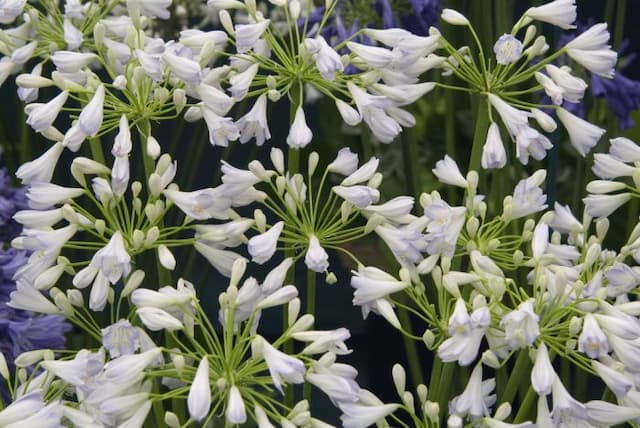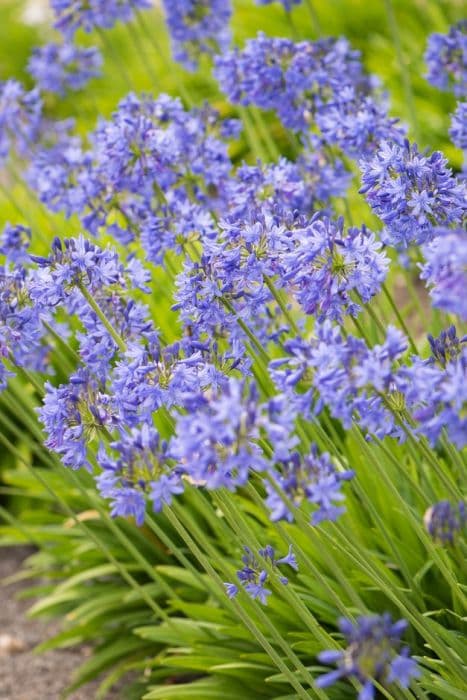African Lily Agapanthus 'Silver Mist'

ABOUT
Agapanthus 'Silver Mist' is recognized for its striking foliage and enchanting flowers. The leaves are variegated with shades of green and creamy white edges, giving it a misty appearance that stands out in any garden setting. As the name suggests, the silver-like hue of the foliage adds a unique, almost luminous quality to the plant's overall aesthetic. Come blooming season, this perennial generates globular clusters of delicate bell-shaped flowers, which are typically a soft blue to violet color. These blossoms are bunched tightly together at the end of tall, sturdy stems that soar above the foliage, presenting an eye-catching display that could remind one of little fireworks. Agapanthus 'Silver Mist' is a clumping plant, meaning it grows in dense groups, which can create a lush, bushy appearance as it matures. This characteristic makes it excellent for use as a border or feature plant in garden beds. It combines the ornamental qualities of both flowers and foliage, maintaining visual interest even when not in bloom due to the variegated leaves that last throughout the growing season.
About this plant
 Names
NamesFamily
Amaryllidaceae
Synonyms
African Lily, Lily of the Nile, Love Flower
Common names
Agapanthus 'Silver Mist'
 Toxicity
ToxicityTo humans
The Agapanthus, commonly known as Lily of the Nile, can be toxic to humans if ingested. The plant contains compounds that are potentially harmful, which can lead to symptoms such as nausea, vomiting, and diarrhea. In some cases, it can also cause dizziness and abdominal pain. It is important to avoid ingesting any part of the plant and to keep it out of reach of children who may mistakenly eat it.
To pets
Lily of the Nile is also toxic to pets if ingested. It contains substances that can cause similar symptoms in pets as it does in humans, including vomiting, nausea, and diarrhea. Additionally, it may lead to lethargy or more serious effects such as tremors or cardiac issues, depending on the amount consumed. It is important to prevent pets from chewing or ingesting any part of the plant to avoid these potential health issues.
 Characteristics
CharacteristicsLife cycle
Perennials
Foliage type
Evergreen
Color of leaves
Green
Flower color
Blue
Height
2 feet (0.61 meters)
Spread
2 feet (0.61 meters)
Plant type
Bulb
Hardiness zones
8
Native area
South Africa
Benefits
 General Benefits
General Benefits- Ornamental Appeal: Agapanthus 'Silver Mist', commonly known as Lily of the Nile, offers striking, globular flower clusters that can add aesthetic value to landscapes and gardens.
- Drought Tolerance: Once established, Lily of the Nile is quite tolerant of drought, making it suitable for water-wise gardens.
- Low Maintenance: It requires minimal upkeep beyond occasional watering and deadheading, cutting down on gardening efforts.
- Attracts Pollinators: The flowers attract bees and butterflies, promoting pollination in the garden.
- Long Blooming Season: Lily of the Nile typically enjoys a long flowering period, providing color and interest throughout the season.
- Architectural Structure: The plant's upright leaves and tall flower stalks add structure and form to garden design.
- Versatility: It can be used in a variety of settings, including borders, containers, and as focal points in the landscape.
- Disease Resistance: Agapanthus is generally resistant to many diseases, ensuring a healthy garden with less need for chemical treatments.
 Medical Properties
Medical PropertiesThis plant is not used for medical purposes.
 Air-purifying Qualities
Air-purifying QualitiesThis plant is not specifically known for air purifying qualities.
 Other Uses
Other Uses- Photography subject: Due to its attractive foliage and unique variegation, it can be used by photographers as a subject for botanical photography or as a natural backdrop for portraits.
- Bee and butterfly garden: Agapanthus 'Silver Mist' is suitable for planting in gardens designed to attract pollinators like bees and butterflies because of its nectar-rich blooms.
- Floral art: The plant's striking flower stalks can be used in floral arrangements and contemporary plant art pieces.
- Coastal landscaping: It is salt-tolerant and can be used in coastal gardens to add greenery without the need for constant fresh water resources.
- Poolside decoration: Because of its clumping nature and low-maintenance requirements, it is ideal for planting around pools where it can add a touch of elegance without dropping debris into the water.
- Theme gardens: It can be incorporated into themed gardens, such as a silver and blue color-themed garden, complementing other plants with similar hues.
- Erosion control: The plant's root system can help stabilize soil on slopes or banks, making it a functional as well as an ornamental plant choice.
- Container gardening: The 'Silver Mist' variety can be grown in pots or containers where space is limited, such as balconies or patios.
- Culinary presentation: Though not edible, the vibrant flowers can be used as a non-toxic garnish for plates in high-end culinary presentations to add color and visual interest.
- Artistic inspiration: The plant's form and colors can inspire artists and designers in their work, providing natural shapes and textures for paintings, fashion, or fabric designs.
Interesting Facts
 Feng Shui
Feng ShuiThe African Lily is not used in Feng Shui practice.
 Zodiac Sign Compitability
Zodiac Sign CompitabilityThe African Lily is not used in astrology practice.
 Plant Symbolism
Plant Symbolism- Love Letters: The name Agapanthus comes from the Greek words 'agape' meaning love, and 'anthos' meaning flower. The 'Silver Mist' variety could symbolize delicate and precious messages of love.
- Beauty: With its striking appearance and elegant color, Agapanthus 'Silver Mist' is often seen as a symbol of beauty and attractiveness.
- Endurance and Survival: This plant is known for its toughness and ability to survive in challenging conditions, representing endurance and the will to persist.
- Purity and Innocence: The 'Silver Mist' variety, with its silvery foliage, may represent purity, clarity, and innocence.
- Fertility: Agapanthus is sometimes associated with fertility due to its lush and bountiful flowering habits.
 Water
WaterLily of the Nile should be watered deeply but infrequently to encourage a deep root system, which should occur about once a week during the growing season depending on environmental conditions. In general, aim to provide about 1 inch of water, equivalent to approximately 0.6 gallons per square yard, each week. During periods of extreme heat or dryness, watering frequency may need to increase. Always allow the soil to dry out between waterings to prevent root rot. In the winter months, reduce watering since the plant’s water needs decrease as its growth slows.
 Light
LightLily of the Nile thrives in full sun to partial shade. The ideal location is a spot where it can receive at least six hours of direct sunlight daily. However, in regions with extremely hot summers, afternoon shade is beneficial to prevent scorching of the leaves. Avoid deep shade, as this can lead to poor blooming and leggy growth.
 Temperature
TemperatureLily of the Nile prefers temperate conditions and can tolerate temperatures as low as 20 degrees Fahrenheit for brief periods, but it is best grown where the temperature rarely drops below 25 degrees Fahrenheit. The ideal temperature range for active growth lies between 60 and 75 degrees Fahrenheit. Plants may require protection, such as mulching or covering, if lower temperatures are expected.
 Pruning
PruningPrune Lily of the Nile to remove spent flower stalks and to encourage additional blooming. Trimming should be done immediately after the flowers fade. Dead or damaged foliage can be removed at any time to maintain the plant’s appearance. Pruning is typically done annually, but the plant can tolerate more frequent pruning if needed.
 Cleaning
CleaningAs needed
 Soil
SoilThe best soil mix for Lily of the Nile should be rich, well-draining, and able to retain some moisture. A mixture of loamy soil with added organic matter such as compost or peat moss is ideal. This plant prefers a soil pH of around 6.0 to 7.0.
 Repotting
RepottingLily of the Nile should typically be repotted every 2-3 years, or when the plant becomes pot-bound. Spring is the best time for repotting to allow the plant to establish in the growing season.
 Humidity & Misting
Humidity & MistingLily of the Nile thrives best in moderate humidity levels. While they can tolerate some dry air, they flourish when the humidity is around 40 to 60 percent.
 Suitable locations
Suitable locationsIndoor
Place in bright, indirect light and ensure good air circulation for Lily of the Nile.
Outdoor
Plant in partial sun to full sun in well-draining soil for Lily of the Nile.
Hardiness zone
8-11 USDA
 Life cycle
Life cycleAgapanthus 'Silver Mist', also commonly known as Lily of the Nile, begins its life cycle as a seed which germinates in spring if sown after the last frost. The seedling grows into a vegetative stage with strap-like leaves and establishes a root system. As it matures, typically within a few years, it forms a clump of foliage and starts producing tall stalks with rounded clusters of star-shaped flowers, usually in shades of blue, white, or purple during the summer months. After blooming, the flowers develop into seed capsules if not deadheaded, allowing for self-seeding or seed harvest for propagation. Once established, Agapanthus enters a perennial cycle of going dormant in the winter, with foliage dying back, and then vigorously regrowing from its rhizome in the spring. Over time, the clumps may become crowded, necessitating division and replanting to rejuvenate growth and improve flowering.
 Propogation
PropogationPropogation time
Spring-Early Summer
The Agapanthus, commonly known as Lily of the Nile, is relatively easy to propagate. The most popular method is division of the plant’s clump. Typically, the best time to divide Agapanthus is in the early spring or late fall when the plant is not actively blooming. To propagate by division, carefully lift the entire plant out of the ground with a shovel, minimizing damage to the roots. Once out of the soil, you can gently pull apart the clumps into smaller sections, ensuring that each section has at least one or two growing points or shoots. Replant the divisions immediately, maintaining the same soil depth as before and water them well to help establish the newly transplanted divisions. This process not only propagates new plants but also rejuvenates older clumps that may have become too dense, which could affect their blooming.









